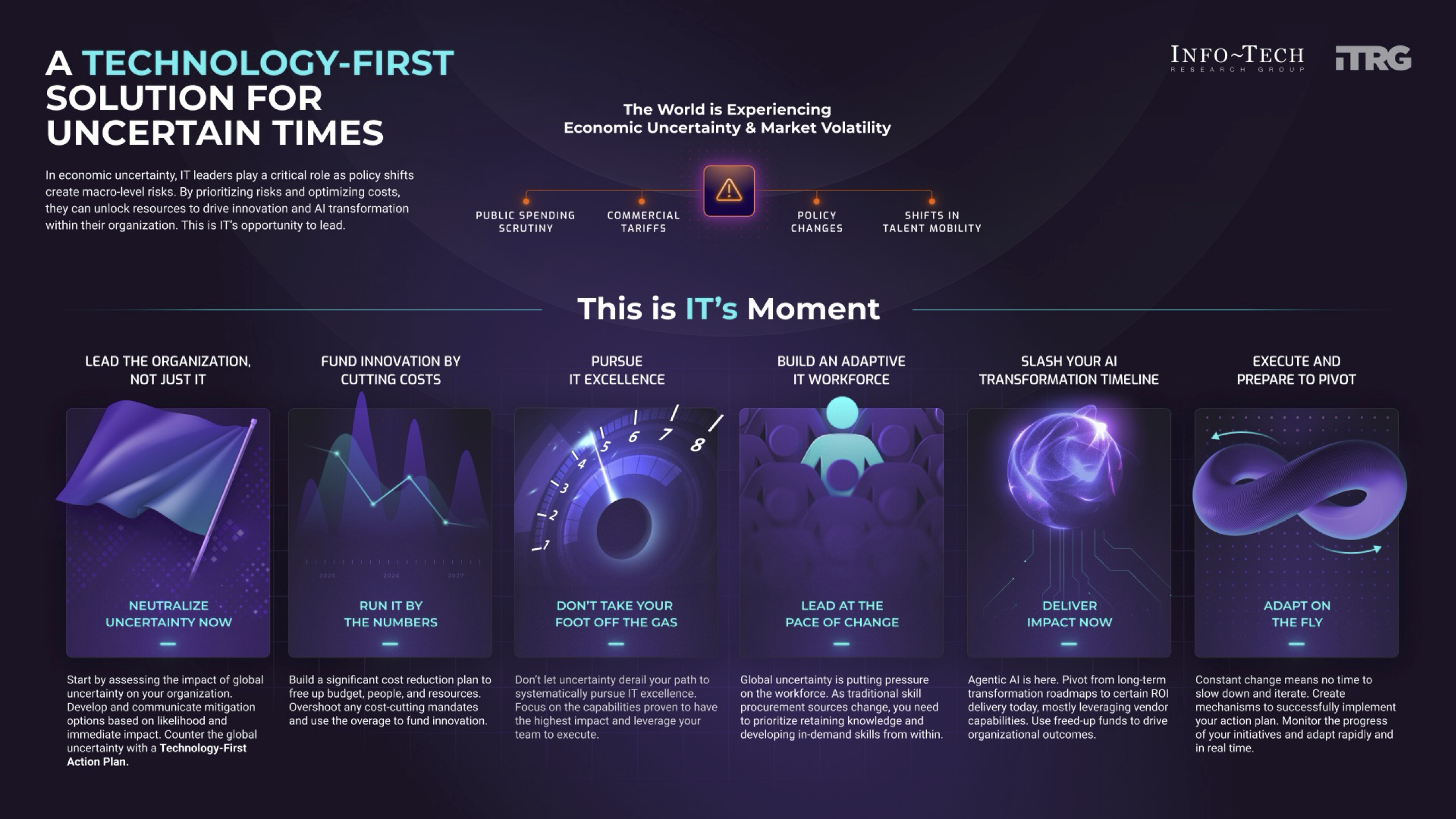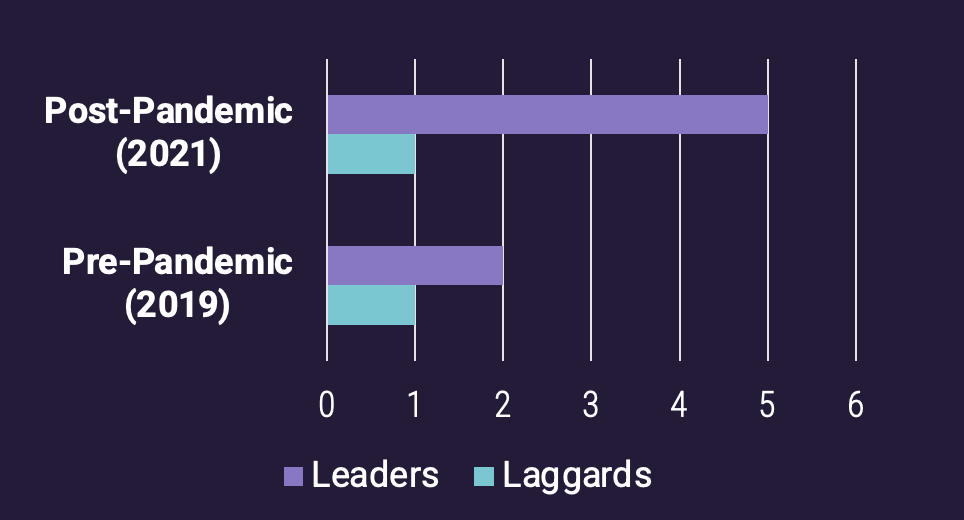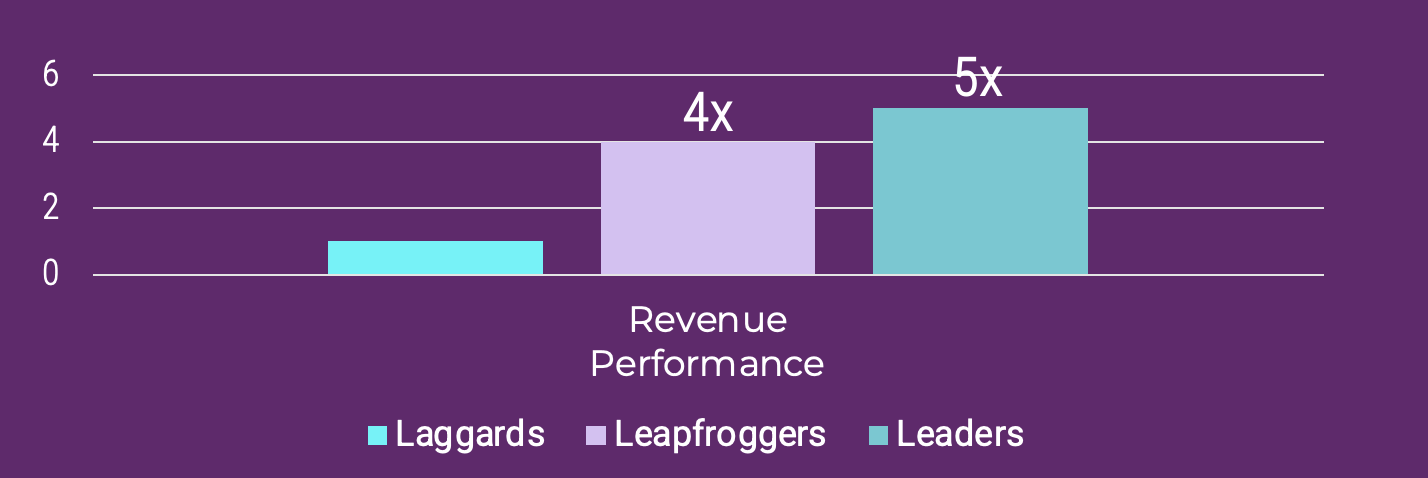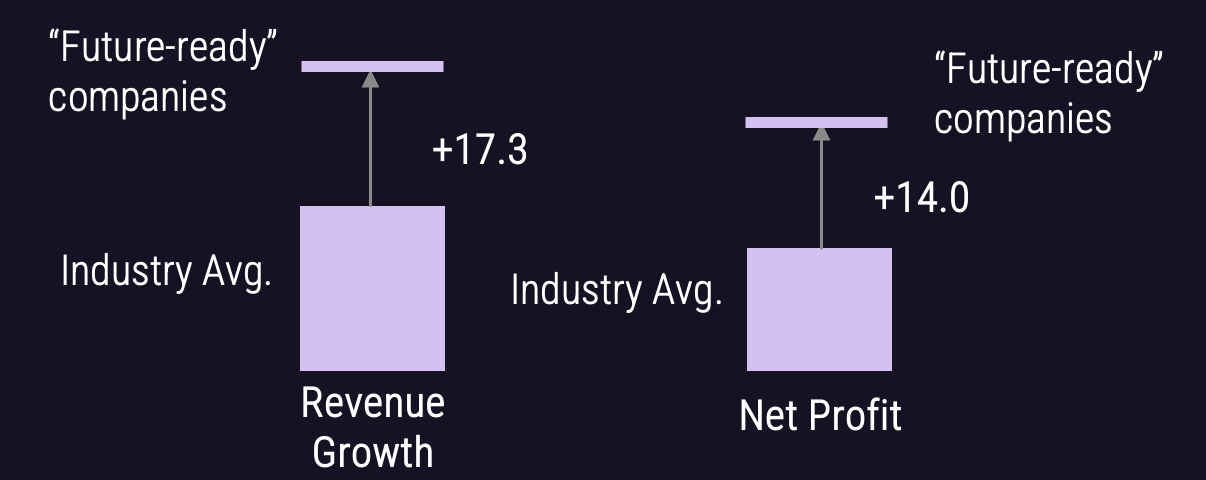Shrinking budgets, escalating trade wars, and endless policy and regulation changes are putting an increasing strain on organizations and their IT departments. In spite of spending cuts, talent shortages, and vendor uncertainty, this disruptive environment offers an opportunity for IT to be more than simply the first responder from a technology standpoint. Organizations weathering the headwinds of macro-uncertainty are hungry for proactive digital leadership, and CIOs are best equipped to be the architects of that strategic response. Our step-by-step blueprint can help IT leaders build a Technology-First Action Plan that will turn today’s volatility into tomorrow’s value.
Too much of IT’s energy is spent on keeping up with this economic and policy turmoil, instead of on positioning the organization to thrive within it. IT leaders must prioritize risks and optimize costs to ensure IT is able to foster innovation, including AI transformation, within their organizations – not only to drive organizational value, but to showcase IT’s worth as a technology-enabled organizational leader. This is IT’s moment.
1. Cut costs to free up resources for innovation.
Innovation drives new ways of generating organizational value but often sees its budget slashed amid budget constraints. IT leaders must cut unnecessary costs and redirect that spending to the people, resources, and budgetary capacity their innovation efforts will need to overcome today’s turmoil.
2. Meet the moment. Take the lead.
As much as today’s uncertainty is a strain on IT’s resources, it can also be an opportunity. By demonstrating that their technological know-how can be used not only to solve problems but also to enable better decision-making, CIOs can prove their ability to lead not just IT, but the organization as a whole.
3. 91��Ƭ�� an adaptive IT team.
With technology advancing at an exponential rate, you will never permanently close the skills gap. Focus instead on building sustainable learning and development practices to enable your staff to retain knowledge and develop in-demand skills as they are needed.
Use this step-by-step blueprint to realign IT to lead through uncertainty
Our research offers guidance and templates to make a clear assessment of IT’s strengths and vulnerabilities, and where they can be leveraged. Use our Technology-First Action Plan framework to empower IT to lead the organization through disruption.
- Assess uncertainties and opportunities by leveraging this moment to explore where the organization is most vulnerable and where it is most poised to further lean into technology risks.
- Review IT Spend & Staffing tools and services to find costs that can be either cut or channeled toward innovation opportunities.
- 91��Ƭ�� your Technology-First Action Plan by identifying and prioritizing initiatives that will drive the organization forward, and consolidate those initiatives into a 12-month plan.
- Prepare to execute by defining the organizational value of your plan and building an adjustable communications strategy to bring stakeholders on board.
Workshop: Adapt to Uncertainty With a Technology-First Action Plan
Workshops offer an easy way to accelerate your project. If you are unable to do the project yourself, and a Guided Implementation isn't enough, we offer low-cost delivery of our project workshops. We take you through every phase of your project and ensure that you have a roadmap in place to complete your project successfully.
Module 1: Elicit Critical Data
The Purpose
Ahead of engaging in the workshop, your organization will need to acquire and be ready to leverage critical data.
Key Benefits Achieved
Insight into where IT spending and staff time is spent as well as how this will engage existing strategies.
Activities
Outputs
(Recommended) Complete the IT Staffing Diagnostic
- Diagnostic reports for IT Spend & Staffing
(Required) Complete IT Spend & Staffing assessment
- Diagnostic reports for IT Spend & Staffing
(Recommended) Complete vendor contracts reviews
Review your current strategic documents: IT Strategy, Innovation Strategy, etc.
(Optional) Review existing Business Continuity Plan (BCP) for relevance and coverage.
Module 2: Assess Uncertainties & Opportunities
The Purpose
As macro vulnerabilities create more uncertainty for your organization, actively identify which ones are most impactful for your organization and identify opportunities to leverage technology.
Key Benefits Achieved
- Understand the macro vulnerabilities that impact your organization.
- Tie the impact of those vulnerabilities to organizational and IT risks.
- Prioritize the risks that require immediate attention.
Activities
Outputs
Scan the environment to understand emerging macro-vulnerabilities.
- Alignment on purpose of the Technology-First Action Plan
Identify organizational impacts and opportunities.
Determine new IT risks and assess risk severity in an integrated risk register.
Prioritize IT risks based on organizational risk tolerance.
- Prioritized list of organizational risks and responses in the face of macro uncertainties.
Decide on risk mitigation responses.
Consider technology-enabled opportunities to focus in on.
- List of technology-first opportunities.
Module 3: Review Resourcing, Vendors & Budgets
The Purpose
Key Benefits Achieved
- Understand IT’s spending.
- Identify core opportunities to optimize costs around systems, contracts, projects, and workforce.
Activities
Outputs
Review IT Staff and Spending allocations across the four views: Expenses, IT Services, Business Lines, and Innovation.
- Understand current spending as it relates to staffing, budget, and vendors.
Identify cost optimization actions across: Vendor consolidation & re-negotiation, Project portfolio rationalization, Systems rationalization, Workforce productivity.
- Identified cost optimization initiatives.
Module 4: 91��Ƭ�� Your Technology-First Action Plan
The Purpose
Key Benefits Achieved
- A technology-first approach to mitigating macro vulnerabilities to the organization.
- Explores a high number of possible actions that can be taken to mitigate organizational risk.
- A roadmap that spans people, processes, and technology.
Activities
Outputs
Identify actions to improve IT capabilities and execute.
Identify actions that retain and develop top talent in the organization.
Identify actions that leverage AI and innovation to transform the organization.
Prioritize actions based on impact to reduce risk or seize opportunities.
- Prioritized list of initiatives
Consolidate initiatives into a 12-month Technology-First Action Plan.
- 12-month roadmap for the Technology-First Action Plan
Module 5: Define Your Execution Strategy
The Purpose
Key Benefits Achieved
- Align the Technology-First Action Plan back to core organizational value metrics.
- Prepare initiative owners for what is required to be successful.
- Be prepared to communicate the Technology-First Action Plan with critical stakeholders.
Activities
Outputs
Define owners, purpose, and critical criteria for the success of each initiative.
- Establish mechanisms to ensure the success of your plan.
91��Ƭ�� one-page initiative descriptions.
- Establish mechanisms to ensure the success of your plan.
Identify the impact the Technology-First Action Plan has on organizational value.
91��Ƭ�� a communication plan.
- Defined communications strategy.
Discuss next steps and wrap-up.
Adapt to Uncertainty With a Technology-First Action Plan
Cost cutting in times of crisis works; doubling down on innovation works even better.
Analyst perspective
Cost cutting in times of crisis works; doubling down on innovation works even better.

CIOs occupy the one seat that spans every data stream, workflow, and control point, making them the first to detect how tariffs, tighter budgets, shifting regulations, and talent shortages ripple through the business. Because each shock ultimately shows up as an information or process-velocity problem, the technology function is where early warning meets rapid response.
Fortunately, the tech-enabled toolkit can now neutralize these headwinds: hyperautomation absorbs compliance overhead, Gen AI copilots close skills gaps, FinOps reins in cloud costs when input prices spike, and privacy-preserving analytics keep the business compliant while still monetizing data. Acting now lets the CIO frame tech spend as an “uncertainty hedge,” unlocking resilience and cash before the board defaults to blanket cuts. Proactive digital leadership today prevents passive strictness tomorrow – and no other executive is better equipped to lead it.
91��Ƭ�� a technology-first action plan that can turn today’s volatility into tomorrow’s value.
Brittany Lutes
91��Ƭ�� Director,
91��Ƭ��
Please note: This research was developed with the assistance of generative AI. For information about how, please see in the Appendix
Executive summary
Your challenge
In 2025, organizations faced a series of unexpected macro-vulnerabilities that drastically impacted how they functioned
Spending Scrutiny & Budget Cuts
On the surface, the commitment to reducing spending throughout the public sector might seem localized to those industries. But the reality is that many other organizations are dependent on a stable public spending budget that is being used to purchase private sector products and services. A reduction in public sector spending is a reduction in spending for all.
Escalating Trade Conflicts
While the United States increased the average tariff to 24% (EY, 2025), we were already witnessing massive trade impacts due to increasing tensions between several countries. Organizations that import goods have been struggling to either find new suppliers or come up with costs to cover the additional tariff fees – which are changing at a moment’s notice.
Abundant Policy & Regulation Changes
Globally, we are seeing an increased involvement of government organizations in how they regulate and oversee public and private organizations. Some of these regulations are increasingly technological in nature with AI or data protection concerns, but others relate to taxes, vendor compliance, the environment, and workforce mandates. Failing to understand these mandates will be costly.
Executive summary
Common obstacles
For CIOs and IT leaders, these vulnerabilities present challenges to achieving their technology mandates
Forced to Be in Crisis Response
For most CIOs and IT leaders, being in a reactive or operational state is the norm. In fact, based on our IT Maturity Scale, 81% of organizations are considered trusted operators or less by their organization (Info-Tech CIO Business Vision, 2024). When macro-risks impact the organization, IT is not seen as the partner or innovator, but as the firefighter expected to react and respond how it’s told. This outdated view leaves IT forced to slash innovation budgets.
Accessing Critical IT Skills & Knowledge
Ongoing budget constraints have exacerbated challenges within the IT talent market that was seeing double-digit percent increases in salary only a few months ago. Unfortunately, despite most (90%) of IT leaders facing a talent gap, salary increases are likely not something that the organization is responsive to during times of uncertainty (Robert Half, 2025). Like everywhere else, IT departments are facing hiring freezes and stagnant salaries, requiring a new approach to learning and development to get the skills you need today.
IT Sourcing & Vendor Complexity
Given that 62% of IT spend is on vendors, this is a particularly important area for IT leaders to focus their time and effort when experiencing this level of macro-economic uncertainty (Info-Tech Spend & Staffing Benchmarking, 2024). As a result of current tariffs, organizations are being forced to increase their diversity of suppliers to limit disruption while simultaneously reducing the IT portfolio of vendors providing applications or platforms.
Executive summary
Resolution
Explore the entire suite of research that supports these pillars by visiting our research center IT’s Moment: A Technology-First Solution for Uncertain Times.
-
Lead the Organization, Not Just IT
Neutralize Uncertainty Now -
Fund Innovation by Cutting Costs
Run IT by the Numbers -
Pursue IT Excellence
Don’t Take Your Foot off the Gas -
91��Ƭ�� an Adaptive IT Workforce
Lead at the Pace of Change -
Slash Your AI Transformation Timeline
Deliver Impact Now -
Execute and Prepare to Pivot
Adapt on the Fly
Info-Tech’s Approach
- Phase 1 – Assess Uncertainties & Opportunities
- Phase 2 – Review Budget, Staffing & Contracts
- Phase 3 – 91��Ƭ�� Your Technology-First Action Plan
- Phase 4 – Get Ready to Execute!

1: Lead the Organization, Not Just IT
Neutralize Uncertainty Now
- Defuse Uncertainty Drivers: Understand organizational impact.
- Lean Into the Curve: Apply Exponential IT.
- Pick Your First Bets: Deliver use cases now.
- Claim Your New Mandate: Technology-first or go out of business.
- Get the Word Out: Tell the entire organization now.
Start by assessing the impact of global uncertainty on your organization. Develop and communicate mitigation options based on likelihood and immediate impact. Counter the global uncertainty with a technology-first action plan.
2: Fund Innovation by Cutting Costs
Run IT by the Numbers
- Don’t Bet the Farm: Set the innovation budget.
- Find Real Dollars Quickly: Cut costs now.
- Demonstrate Technology Impact: Benchmark spend and shift.
- Shorten the Cycles: 91��Ƭ�� a flexible budget (finally).
- Sharpen the Pencil: Renegotiate vendor contracts.
20%
Only 20% of CFOs are happy with the impact tech investments make on their business (Remini Street, 2024).
91��Ƭ�� a significant cost reduction plan to free up budget, people, and resources. Overshoot any cost-cutting mandates and use the overage to fund innovation.
3: Pursue IT Excellence
Don’t Take Your Foot off the Gas
- Get the Baseline: Understand your maturity.
- Focus on What Really Matters: Improve your critical capabilities.
- You Can’t Do IT Alone: Guide your team.
- Enable Everyone: Provide tools and training.
- Aim High Selectively: Leapfrog for impact.
85%
85% of core processes are ineffective on average across all IT organizations (Info-Tech IT Management & Governance Diagnostic, 2024).
Don’t let uncertainty derail your path to systematically pursue IT excellence. Focus on the capabilities proven to have the highest impact and leverage your team to execute.
4: 91��Ƭ�� an Adaptive IT Workforce
Lead at the Pace of Change
- Knowledge Is Power: Stop the drain.
- Drive Adaptability: Be it and teach it.
- Lead the Pack: Autonomize aggressively.
- Fill Your Gaps: 91��Ƭ�� critical skills.
- Win the Race for Talent: Money isn’t everything.
IT positions that are going unfilled are costing organizations in the United States an average of $187 billion in lost revenue each year (CompTIA, 2024).
Global uncertainty is putting pressure on the workforce. As traditional skill procurement sources change, you need to prioritize retaining knowledge and developing in-demand skills from within.
5: Slash Your AI Transformation Timeline
Deliver Impact Now
- Just Do It: Deliver AI now.
- Stop Saying No: Democratize AI.
- Spend, Spend, Spend: Overfund innovation.
- Have ONE Strategy: AI Strategy = IT Strategy = Enterprise Strategy
- If in Doubt, Buy Over 91��Ƭ��: Select the right vendors.
CEOs believe that the researching and implementing AI is the top IT priority (Foundry, 2025).
Agentic AI is here. Pivot from long-term transformation roadmaps to certain ROI delivery today, mostly leveraging vendor capabilities. Use freed-up funds to drive organizational outcomes.
6: Execute and Prepare to Pivot
Adapt on the Fly
- Aim for Impact: Say yes to promising pilots.
- Measure What’s Real and Fund What Works: Fund based on outcomes.
- Let Things Go. Kill failing projects quickly.
- Shatter the Org Chart: Match talent to impact.
- It’s Not Bragging If It’s True: Share wins and failures.
Constant change means no time to slow down. Create mechanisms to successfully implement your action plan. Monitor the progress of your initiatives and adapt rapidly and in real time.
Organizations that accelerated their digital transformation during the pandemic significantly outperformed their peers

The growth advantage that companies that are technology leaders had over laggards went from 2x to 5x post pandemic.1

Organizations that shifted their IT budgets from being operations-centric to innovation-centric – labeled “leapfroggers” – managed to significantly reduce their digital transformation timeline and outperform laggards by four times.1

Companies that are “future-ready,” having gone through digital business transformation and developed the capabilities that enable them to innovate and to engage and satisfy customers while reducing costs, have significantly higher financial performance, with average revenue growth 17.3 percentage points and net margins 14.0 percentage points above industry average.2
1. Accenture, 2021
2. MIT CISR, 2022
Cost cutting in times of crisis works.
Doubling down on innovation works even better.
Innovation outpaces austerity
While your peers and competitors look for ways to follow cost-cutting mandates, look for ways to demonstrate why investment in innovation will take the organization further faster.
Starve waste, feed a revolution
Cut costs relentlessly now to avoid having to give up innovation budget, so you can transform the organization when it is needed most. It is through innovation that the organization will be exposed to new ways of generating organizational value.
Technology powers smart decision-making
This is an opportunity to demonstrate to the organization that IT is not a follower, but a leader. Use your greatest asset – technology – and demonstrate to the organization how it can be used to enable better decision making.
Always be learning
The exponential rate of technology development and adoption means organizations will never close the skill gap again, especially for IT. Focus on establishing sustainable learning and development practices that allow staff to upskill and apply those skills quickly.
Change is constant; struggle is optional
Change is inevitable, but it doesn’t have to be hard. Establish adaptive practices in your change plan to ensure that it remains on track and continuously moving in the right direction.
Info-Tech’s methodology for building a Technology-First Action Plan
1. Assess Uncertainties & Opportunities |
2. Review Budget, Staffing & Contracts |
3. 91��Ƭ�� Your Technology-First Action Plan |
4. Get Ready to Execute |
|
Key Activities |
|
|
|
|
Phase Outcomes |
Understand the risks that vulnerabilities are creating for your organization and the technology-enabled opportunities that need to be seized. | Review your IT budget to determine where there are opportunities to cut costs relentlessly. Funnel these cost savings toward innovative opportunities. | Prioritize initiatives that will drive the organization forward in times of uncertainty. Establish a 12-month roadmap showing when each initiative can be achieved. | Succeed at the action plan with a clear change and communication approach to enable adaptability in the moment when new vulnerabilities inevitably emerge. |
Key deliverable:
Technology-First Action Plan
91��Ƭ�� a Technology-First Action Plan that demonstrates how IT can lead the organization in responding to ongoing uncertainties.
Each phase of this blueprint is accompanied by phases of the supporting deliverable to help you accomplish your goals:
Uncertainties & Opportunities Assessment
Identify how macro-uncertainties are generating new risks for your organization and opportunities to leverage technology more effectively.
IT Spend & Staffing Benchmarking
Assess the current IT spend across systems, contracts, projects, and the workforce to identify cost optimization opportunities.
Technology-First Action Plan Roadmap
Identify key initiatives that IT will pursue and deliver against over the next 12 months to reduce the impacts of uncertainties.
Communication & Execution
Define and prepare to communicate how the Technology-First Action Plan will deliver organizational value.
Blueprint benefits
IT Benefits
- Maintain full control over the timing and scope of any technology-related cost reductions.
- Reallocate freed-up budget to AI and other digital transformation initiatives that fuel continuous innovation.
- Gain early visibility into emerging risks that could impact both the enterprise and the IT function.
- Systematically enhance critical IT capabilities and translate them into measurable performance gains.
- Maximize existing technical talent through targeted upskilling and structured knowledge transfer.
Organizational Benefits
- Mitigate macro-level uncertainties through a proactive, risk-aligned action plan.
- Outperform competitors by remaining resilient and focused on opportunities during periods of volatility.
- Shift leadership effort from diagnosing uncertainty to executing decisive, innovative responses.
- Strengthen cross-functional collaboration to simultaneously reduce risk and capture new value.
Measure the value of this blueprint
The objective of this blueprint is to improve not just IT’s value, but the organization’s value.
ORGANIZATIONAL VALUE
Revenue Acceleration
- Year-over-year (YoY) revenue growth
- Monthly or annual recurring revenue (MRR/ARR) growth
- Customer lifetime value (CLV) growth
Cost Optimization
- Operating-expense ratio (OpEx as % of revenue)
- Procurement savings vs. baseline
- Support cost per customer interaction
Asset Efficiency
- Return on assets (ROA)
- Asset-turnover ratio (revenue ÷ total assets)
- Fixed-asset utilization (uptime vs. downtime)
Customer Satisfaction
- Net Promoter Score (NPS)
- Customer satisfaction score (CSAT)
- Customer effort score (CES)
- Churn and retention rates
- Revenue Acceleration: Launching new or enhanced offerings that open fresh revenue streams faster than the core business can mature.
- Cost Optimization: Optimizing operating expenses while maintaining required service and flexibility.
- Asset Efficiency: Squeezing more output or cash from every asset through higher utilization and faster turnover.
- Customer Satisfaction: Reliably exceeding customer expectations to earn loyalty and advocacy.
91��Ƭ�� Note: Beyond Automation, Beyond Borders: Cultivating Your Talent in a New Global Reality

Fred Chagnon
Principal 91��Ƭ�� Director
91��Ƭ��
While the discourse around artificial intelligence, particularly generative AI, often emphasizes workforce displacement, a strategy fixated on replacing human workers with AI is shortsighted. True value creation in the AI era demands a strategic investment in people – employees and partners – to augment, manage, and innovate with these technologies.
This imperative is critically amplified by emerging de-globalization trends that are reshaping global talent pipelines and increasing the need for organizational self-sufficiency. Sustainable success, innovation, and resilience will therefore hinge on an organization’s commitment to cultivating in-house talent, focusing on skills for AI, cybersecurity, and adaptive leadership to effectively navigate a future defined by human–AI cocreation.
“The evidence suggests that, rather than seeking to replace people with AI, organizations that prioritize employee development alongside their AI investments will be better positioned to innovate, navigate ethical complexities, build customer trust, and ultimately unlock the full, transformative potential of AI and other exponential technologies.
In an era where both technological disruption and geopolitical fragmentation demand greater organizational resilience, focusing on developing our people internally becomes the linchpin of any successful AI strategy and, indeed, overall business strategy.”
Info-Tech offers various levels of support to best suit your needs
DIY Toolkit
"Our team has already made this critical project a priority, and we have the time and capability, but some guidance along the way would be helpful."
Guided Implementation
"Our team knows that we need to fix a process, but we need assistance to determine where to focus. Some check-ins along the way would help keep us on track."
Workshop
"We need to hit the ground running and get this project kicked off immediately. Our team has the ability to take this over once we get a framework and strategy in place."
Executive & Technical Counseling
"Our team and processes are maturing; however, to expedite the journey we'll need a seasoned practitioner to coach and validate approaches, deliverables, and opportunities."
Consulting
"Our team does not have the time or the knowledge to take this project on. We need assistance through the entirety of this project."





 Navigate the Digital ID Ecosystem to Enhance Customer Experience
Navigate the Digital ID Ecosystem to Enhance Customer Experience
 Document Business Goals and Capabilities for Your IT Strategy
Document Business Goals and Capabilities for Your IT Strategy
 91��Ƭ�� a Business-Aligned IT Strategy
91��Ƭ�� a Business-Aligned IT Strategy
 Define Your Digital Business Strategy
Define Your Digital Business Strategy
 Drive Digital Transformation With Platform Strategies
Drive Digital Transformation With Platform Strategies
 Make IT a Partner in Successful M&A Due Diligence
Make IT a Partner in Successful M&A Due Diligence
 Make IT a Successful Partner in M&A Integration
Make IT a Successful Partner in M&A Integration
 Plan Your Digital Transformation on a Page
Plan Your Digital Transformation on a Page
 Review Your Application Strategy
Review Your Application Strategy
 Start Making Data-Driven People Decisions
Start Making Data-Driven People Decisions
 2021 CIO Priorities Report
2021 CIO Priorities Report
 Create a Work-From-Anywhere Strategy
Create a Work-From-Anywhere Strategy
 Mergers & Acquisitions: The Sell Blueprint
Mergers & Acquisitions: The Sell Blueprint
 Mergers & Acquisitions: The Buy Blueprint
Mergers & Acquisitions: The Buy Blueprint
 CIO Priorities 2023
CIO Priorities 2023
 Communicate Any IT Initiative
Communicate Any IT Initiative
 Effective IT Communications
Effective IT Communications
 Establish an Integrated IT-Business Operating Model
Establish an Integrated IT-Business Operating Model
 Info-Tech Quarterly 91��Ƭ�� Agenda Outcomes Q2/Q3 2023
Info-Tech Quarterly 91��Ƭ�� Agenda Outcomes Q2/Q3 2023
 Business Vision Diagnostic – Annual IT Improvement Program
Business Vision Diagnostic – Annual IT Improvement Program
 Establish Your Digital Transformation Governance
Establish Your Digital Transformation Governance
 Info-Tech Quarterly 91��Ƭ�� Agenda Outcomes Q4 2023
Info-Tech Quarterly 91��Ƭ�� Agenda Outcomes Q4 2023
 Master Your Change Story for Digital Transformation
Master Your Change Story for Digital Transformation
 Info-Tech’s Best of 2023: The Year IT Reached an Inflection Point
Info-Tech’s Best of 2023: The Year IT Reached an Inflection Point
 Prepare for AI Regulation
Prepare for AI Regulation
 Crack the Code to Successful Transformation Management
Crack the Code to Successful Transformation Management
 Info-Tech Diagnostics: Identify and Leverage Your Strengths
Info-Tech Diagnostics: Identify and Leverage Your Strengths
 The CIO Playbook: 8 Secrets and 12 Steps to Systematically Achieve IT Excellence
The CIO Playbook: 8 Secrets and 12 Steps to Systematically Achieve IT Excellence
 Develop an M&A IT Playbook
Develop an M&A IT Playbook
 Adapt to Uncertainty With a Technology-First Action Plan
Adapt to Uncertainty With a Technology-First Action Plan
 Digital Transformation: A Revolution That Lost Its Way
Digital Transformation: A Revolution That Lost Its Way
 The CIO Playbook
The CIO Playbook
 The Essential IT Playbook
The Essential IT Playbook
 Visualize the Industry of the Future
Visualize the Industry of the Future